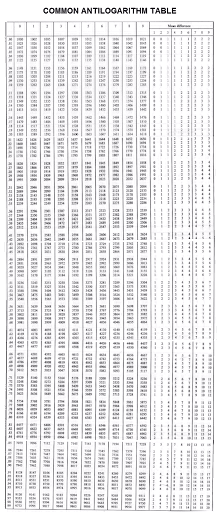
In mathematics, antilogarithms (or antilogs) are a fundamental concept that often comes across in scientific calculations, engineering, and various applied fields. Understanding how to calculate antilogarithms is important for anyone working with logarithms or exponential functions.
This article aims to guide you through the process of calculating antilogarithms step-by-step, ensuring a clear and comprehensive understanding of the concept.
What is Antilog?
The antilogarithm commonly called antilog, is the mathematical operation that undoes the logarithm. It's a fine function that helps us find the original value from a given logarithmic value. In simpler terms, the antilog allows us to determine the actual number when we only have the logarithm of that number.
The formula:
Antilog(x) = bx.
Here, 'x' represents the logarithmic value, and ‘b’ represents the base.
How do we calculate the Antilog?
Understanding the parts of the logarithm mantissa and its characteristics is important to find the antilog of a number. Let's explore each part:
- Characteristic: The characteristic is an integer part of the logarithm. In a logarithm expression like log(x), the characteristic represents the whole number part of the result.
- Mantissa: The decimal part of the logarithm is the mantissa. It is the fractional portion following the characteristic. In a logarithm expression like log(x), the mantissa represents the decimal value that gives the complete logarithm when combined with the characteristic.
When finding the antilogarithm, separate the characteristic and mantissa parts.
- The characteristic helps identify the number of digits before the decimal point in the antilogarithm result.
- The mantissa helps determine the decimal value.
Steps:
To calculate the antilogarithm, follow these steps:
Identify the characteristic and mantissa from the logarithm value.
Compute the antilogarithm of the mantissa
Adjust for the characteristic: Move the decimal point in the antilogarithm result depending on the characteristic value.
1. If the characteristic is positive:
Count the number of digits in the characteristic.
Move the decimal point in the antilogarithm result to the right by the same number of digits.
If the antilogarithm result is a whole number, add zeros as necessary after moving the decimal point.
2. If the characteristic is negative:
Take the absolute value (positive value) of the characteristic.
Count the number of zeros before the first non-zero digit in the antilogarithm result.
Move the decimal point in the antilogarithm result to the left by the same number of zeros.
If the antilogarithm result is less than one, add zeros as necessary before moving the decimal point.
Manual calculation of antilogarithms can be time-consuming and prone to errors. To simplify the process, consider using Antilog Calculator by Allmath . This tool is useful for anyone dealing with complex logarithmic data. Enter your logarithm value and base in the provided box and click the calculate button.
How do we use an Antilog Table?
An antilog table provides calculated values of antilogarithms for a range of logarithmic values, it's also known as a logarithm table. To avoid the complex calculations this table helps us.
To use an antilog table:
- Locate the characteristic and Mantissa value in the table.
- Focus on the mantissa. Use the first two digits after the decimal point as the row number and the third digit as the column number in the antilog table.
- Look for the mean difference in the same row corresponding to the fourth digit of the mantissa. Add this mean difference to the value obtained in Step 2.
- Place a decimal point right after the first digit obtained in Step 3.
- Multiply the number obtained in Step 4 by 10 raised to the power of the characteristic. The result is the antilog of the given number.
Properties of Antilog
Antilogarithms possess several interesting properties that are useful in various mathematical calculations. Some of the key properties of anti-logarithms include:
Identity property: The algorithm of 0 is always 1.
Inverse property: antilog(log(x)) = x log(antilog(x)) = x.
Product property: antilog (x + y) = x log (antilog (x)) = x.
Quotient Property: (x - y) = antilog (x) / antilog (y).
These properties enable us to perform various calculations and simplify complex mathematical expressions involving antilogarithms.
Applications of Antilog
Antilogarithms have numerous applications in various fields, including mathematics, physics, engineering, finance, and scientific research. Some noteworthy uses of anti-logarithms are:
Exponential Growth and Decay: Antilogarithms aid in modeling exponential growth and decay phenomena. They are used to calculate the values at different time points based on growth rates or decay rates.
Signal Processing: Antilogarithms are utilized in signal processing algorithms to convert logarithmic measurements back into linear scale values. This conversion is crucial in applications such as audio and image processing.
The versatility of antilogarithms allows for their extensive application across diverse scientific and technical domains.
Example of Antilog
This section will demonstrate how to calculate antilog with the help of examples.
Example 1: (with table)
Calculate the antilog of 2.4856
Solution:
Using an antilog table.
Step 1:
Locate the characteristic and Mantissa value in the table.
Characteristic: 2
Mantissa: 0.4856.
Step 2:
Focus on the mantissa. Use the first two digits after the decimal point 48 as the row number and the third digit 5 as the column number in the antilog table.
Row number = 48
Column number = 5
Corresponding value = 3055 + 4
Step 3:
Look for the mean difference in the same row corresponding to the fourth digit of the mantissa. Add this main difference of 4 to the value obtained in Step 2.
= 3055 + 4 = 3059.
Step 4:
Place a decimal point right after the first digit obtained in Step 3:
= 3.059.
Step 5:
Multiply the number obtained in Step 4 by 10 raised to the power of the characteristic. The result is the antilog of the given number.
= 3.059 × 103 = 305.9
Hence, the antilog of 2.4856 is 305.9.
Example 2: (without table)
Find antilog of 2.4856 without table.
Solution:
Step 1:
Identify the characteristic and mantissa from the logarithm value.
Characteristic: 2
Mantissa: 0.4856
Step 2:
Compute the antilogarithm of the mantissa.
Using the exponential function, calculate the antilogarithm of the mantissa value:
Antilogarithm of 0.4856 = 10(0.4856)
Step 3:
Adjust for the characteristic.
Since the characteristic is 2, move the decimal point two places to the right.
Multiply the antilogarithm result by 100:
Adjusted antilogarithm = Antilogarithm of 0.4856 × 100
Now, we need to evaluate the exponential function using a calculator or mathematical software:
Antilogarithm of 0.4856 ≈ 3.0445
Step 4:
Adjusted antilogarithm = 3.0445 × 100
Multiply 3.0445 by 100:
Adjusted antilogarithm ≈ 304.45.
Conclusion
In this article, we explored the concept of antilogarithm, its calculation method, properties, and applications, and provided examples. Antilog is essential in undoing logarithms and finding the original values. Whether using an antilog table or mathematical calculations, understanding the characteristics and mantissa helps in accurate results. Antilog finds applications in various fields like exponential growth, signal processing, and more.






